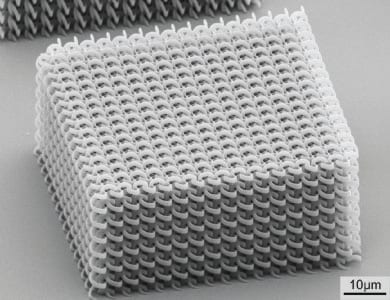In naturally occurring matter, the molecular composition determines what properties the matter will exhibit. This is different in metamaterials. Metamaterials are specially designed composite artificial materials that show properties not present in nature, which arise from the materials’ structure rather than their composition. There has been a lot of research into metamaterials with negative refractive index, with the most popular idea that of an invisibility cloak. However, metamaterials are much more than this; they may open up a broad range of potential new application as they offer unprecedented control of wave propagation.
Although this control can already be demonstrated in 2D metamaterials, practical applications require 3D bulk-like structures. Although wave propagation in the gigahertz frequency range has already been achieved in bulk, the terahertz range is still a challenge. Now, Herbert O. Moser from the Karlsruhe Institute of Technology (KIT, Karlsruhe, Germany), and Carsten Rockstuhl from the University Jena (Germany) have reviewed the latest work in 3D terahertz metamaterials. They discuss current developments and applications as well as options to manufacture 3D THz bulk materials and theoretical means to calculate their performance.
“As the engineered sub-structures must be smaller than their design wavelength, micro/nanomanufacturing is exploited from primary pattern generation over lithography to templating and molecular beam epitaxy”, the authors explain. “The 3D metamaterials were made by stacking of layers, multilayer structuring, and 3D primary pattern generation. Theory shows that full properties may build up over one or a very few layers.”
Despite their complexity, effective properties can frequently be extracted by conceptualizing metamaterials as homogeneous and isotropic media with dispersive electric permittivity and magnetic permeability. For an ideal isotropic medium, strong dispersion in these properties causes wave and field vectors to form a left-handed (E,H,k)-frame involving backward waves, and offering control of quantities like the refractive index which may become negative. Experimental evidence exists from microwaves to the visible. “Metamaterials in the frequency range from about 1 THz to 750 THz are a rapidly evolving field which is likely to have many surprises in store beyond the plethora of ongoing development lines”, Moser and Rockstuhl are convinced.
“The very recent years have shown quite a few unexpected developments including invisibility cloaking and optical illusion, continuous-index photon traps, optical attractors, optical black holes or omnidirectional light absorbers, and the reversed Cherenkov effect”, they point out. “Besides the continuous exploration of new concepts, the engineering development is likely to become stronger as there are promising useful real-world applications including optical components and systems, the evolution of metatronics to integrated metananocircuits, sub-wavelength resolution microscopy predominantly in the infrared, and the wide field of sensors.”


















